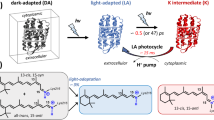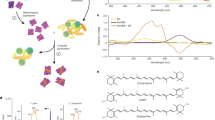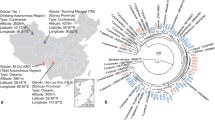Abstract
Proteorhodopsin (PR) is a photoprotein that functions as a light-driven proton pump in diverse marine Bacteria and Archaea. Recent studies have suggested that PR may enhance both growth rate and yield in some flavobacteria when grown under nutrient-limiting conditions in the light. The direct involvement of PR, and the metabolic details enabling light-stimulated growth, however, remain uncertain. Here, we surveyed transcriptional and growth responses of a PR-containing marine flavobacterium during carbon-limited growth in the light and the dark. As previously reported (Gómez-Consarnau et al., 2007), Dokdonia strain MED134 exhibited light-enhanced growth rates and cell yields under low carbon growth conditions. Inhibition of retinal biosynthesis abolished the light-stimulated growth response, supporting a direct role for retinal-bound PR in light-enhanced growth. Among protein-coding transcripts, both PR and retinal biosynthetic enzymes showed significant upregulation in the light. Other light-associated proteins, including bacterial cryptochrome and DNA photolyase, were also expressed at significantly higher levels in the light. Membrane transporters for Na+/phosphate and Na+/alanine symporters, and the Na+-translocating NADH-quinone oxidoreductase (NQR) linked electron transport chain, were also significantly upregulated in the light. Culture experiments using a specific inhibitor of Na+-translocating NQR indicated that sodium pumping via NQR is a critical metabolic process in the light-stimulated growth of MED134. In total, the results suggested the importance of both the PR-enabled, light-driven proton gradient, as well as the generation of a Na+ ion gradient, as essential components for light-enhanced growth in these flavobacteria.
Similar content being viewed by others
Log in or create a free account to read this content
Gain free access to this article, as well as selected content from this journal and more on nature.com
or
Accession codes
References
Anantharaman V, Koonin EV, Aravind L . (2001). Regulatory potential, phyletic distribution and evolution of ancient, intracellular small-molecule-binding domains. J Mol Biol 307: 1271–1292.
Armstrong G . (1999). Carotenoid genetics and biochemistry. In: Cane DE (ed.). Isoprenoids Including Carotenoids and Steroids vol. 2. Elsevier: Amsterdam, The Netherlands. pp 321–352.
Attwood PV, Wallace JC . (2002). Chemical and catalytic mechanisms of carboxyl transfer reactions in biotin-dependent enzymes. Acc Chem Res 35: 113–120.
Béjà O, Aravind L, Koonin EV, Suzuki MT, Hadd A, Nguyen LP et al. (2000). Bacterial rhodopsin: evidence for a new type of phototrophy in the sea. Science 289: 1902–1906.
Béjà O, Spudich EN, Spudich JL, Leclerc M, DeLong EF . (2001). Proteorhodopsin phototrophy in the ocean. Nature 411: 786–789.
Benjamini Y, Hochberg Y . (1995). Controlling the false discovery rate: a practical and powerful approach to multiple testing. J R Statist Soc B 57: 289–300.
Brown LS, Jung K-H . (2006). Bacteriorhodopsin-like proteins of eubacteria and fungi: the extent of conservation of the haloarchaeal proton-pumping mechanism. Photochem Photobiol Sci 5: 538–546.
Cunningham FX, Sun Z, Chamovitz D, Hirschberg J, Gantt E . (1994). Molecular structure and enzymatic function of lycopene cyclase from the cyanobacterium Synechococcus sp strain PCC7942. Plant Cell 6: 1107–1121.
de la Torre JR, Christianson LM, Béjà O, Suzuki MT, Karl DM, Heidelberg J et al. (2003). Proteorhodopsin genes are distributed among divergent marine bacterial taxa. Proc Natl Acad Sci USA 100: 12830–12835.
DeLong EF . (2009). The microbial ocean from genomes to biomes. Nature 459: 200–206.
DeLong EF, Béjà O . (2010). Light-driven proton pump proteorhodopsin enhances bacterial survival during tough times. PLoS Biol 8: .
Eisen MB, Spellman PT, Brown PO, Botstein D . (1998). Cluster analysis and display of genome-wide expression patterns. Proc Natl Acad Sci USA 95: 14863–14868.
Frigaard N-U, Martinez A, Mincer TJ, DeLong EF . (2006). Proteorhodopsin lateral gene transfer between marine planktonic Bacteria and Archaea. Nature 439: 847–850.
Futamata H, Kaiya S, Sugawara M, Hiraishi A . (2009). Phylogenetic and transcriptional analyses of a tetrachloroethene-dechlorinating ‘Dehalococcoides’ enrichment culture TUT2264 and its reductive-dehalogenase genes. Microbes Environ 24: 330–337.
Gardner PP, Daub J, Tate JG, Nawrocki EP, Kolbe DL, Lindgreen S et al. (2009). Rfam: updates to the RNA families database. Nucleic Acids Res 37: D136–D140.
Gillet R, Felden B . (2001). Emerging views on tmRNA-mediated protein tagging and ribosome rescue. Mol Microbiol 42: 879–885.
Giovannoni SJ, Bibbs L, Cho J-C, Stapels MD, Desiderio R, Vergin KL et al. (2005). Proteorhodopsin in the ubiquitous marine bacterium SAR11. Nature 438: 82–85.
Gomelsky M, Klug G . (2002). BLUF: a novel FAD-binding domain involved in sensory transduction in microorganisms. Trends Biochem Sci 27: 497–500.
Gómez-Consarnau L, Akram N, Lindell K, Pedersen A, Neutze R, Milton DL et al. (2010). Proteorhodopsin phototrophy promotes survival of marine bacteria during starvation. PLoS Biol 8: e1000358.
Gómez-Consarnau L, González JM, Coll-Lladó M, Gourdon P, Pascher T, Neutze R et al. (2007). Light stimulates growth of proteorhodopsin-containing marine Flavobacteria. Nature 445: 210–213.
González JM, Fernández-Gómez B, Fernàndez-Guerra A, Gómez-Consarnau L, Sánchez O, Coll-Lladó M et al. (2008). Genome analysis of the proteorhodopsin-containing marine bacterium Polaribacter sp. MED152 (Flavobacteria). Proc Natl Acad Sci USA 105: 8724–8729.
Häse CC, Mekalanos JJ . (1999). Effects of changes in membrane sodium flux on virulence gene expression in Vibrio cholerae. Proc Natl Acad Sci USA 96: 3183–3187.
Izui K, Matsumura H, Furumoto T, Kai Y . (2004). Phosphoenolpyruvate carboxylase: a new era of structural biology. Annu Rev Plant Biol 55: 69–84.
Jitrapakdee S, St Maurice M, Rayment I, Cleland WW, Wallace JC, Attwood PV . (2008). Structure, mechanism and regulation of pyruvate carboxylase. Biochem J 413: 369–387.
Keiler KC . (2008). Biology of trans-translation. Annu Rev Microbiol 62: 133–151.
Lami R, Cottrell MT, Campbell BJ, Kirchman DL . (2009). Light-dependent growth and proteorhodopsin expression by Flavobacteria and SAR11 in experiments with Delaware coastal waters. Environ Microbiol 11: 3201–3209.
Martinez A, Bradley AS, Waldbauer JR, Summons RE, DeLong EF . (2007). Proteorhodopsin photosystem gene expression enables photophosphorylation in a heterologous host. Proc Natl Acad Sci USA 104: 5590–5595.
McCarren J, Becker JW, Repeta DJ, Shi Y, Young CR, Malmstrom RR et al. (2010). Microbial community transcriptomes reveal microbes and metabolic pathways associated with dissolved organic matter turnover in the sea. Proc Natl Acad Sci USA 107: 16420–16427.
McCarren J, DeLong EF . (2007). Proteorhodopsin photosystem gene clusters exhibit co-evolutionary trends and shared ancestry among diverse marine microbial phyla. Environ Microbiol 9: 846–858.
Moore SD, Sauer RT . (2007). The tmRNA system for translational surveillance and ribosome rescue. Annu Rev Biochem 76: 101–124.
Moran MA, Miller WL . (2007). Resourceful heterotrophs make the most of light in the coastal ocean. Nat Rev Microbiol 5: 792–800.
Reich M, Liefeld T, Gould J, Lerner J, Tamayo P, Mesirov JP . (2006). GenePattern 2.0. Nat Genet 38: 500–501.
Sabehi G, Loy A, Jung KH, Partha R, Spudich JL, Isaacson T et al. (2005). New insights into metabolic properties of marine bacteria encoding proteorhodopsins. PLoS Biol 3: e273.
Shi Y, Tyson GW, DeLong EF . (2009). Metatranscriptomics reveals unique microbial small RNAs in the ocean's water column. Nature 459: 266–269.
Spudich JL, Jung KH . (2005). Microbial rhodopsin: phylogenetic and functional diversity. In: Briggs WR, Spudich JL (eds). Handbook of Photosensory Receptors. Wiley-VCH Verlag GmbH & Co KGaA: Weinheim, Germany. pp 1–24.
Stewart FJ, Ottesen EA, DeLong EF . (2010). Development and quantitative analyses of a universal rRNA-subtraction protocol for microbial metatranscriptomics. ISME J 4: 896–907.
Stingl U, Desiderio RA, Cho J-C, Vergin KL, Giovannoni SJ . (2007). The SAR92 clade: an abundant coastal clade of culturable marine bacteria possessing proteorhodopsin. Appl Environ Microbiol 73: 2290–2296.
Storey JD, Tibshirani R . (2003). Statistical significance for genomewide studies. Proc Natl Acad Sci USA 100: 9440–9445.
Taylor BL, Zhulin IB . (1999). PAS domains: internal sensors of oxygen, redox potential, and light. Microbiol Mol Biol Rev 63: 479–506.
Tokuda H, Unemoto T . (1982). Characterization of the respiration-dependent Na+ pump in the marine bacterium Vibrio alginolyticus. J Biol Chem 257: 10007–10014.
Walter JM, Greenfield D, Bustamante C, Liphardt J . (2007). Light-powering Escherichia coli with proteorhodopsin. Proc Natl Acad Sci USA 104: 2408–2412.
Acknowledgements
We thank Jarone Pinhassi for providing strain MED134 and Francis X (Buddy) Cunningham for providing MPTA. We are also grateful to Jamie W Becker for measuring DOC in media, Frank J Stewart for helping with the rRNA subtraction, Yanmei Shi for helping small RNA analyses and Rachel Barry for work in preparing samples for pyrosequencing. This work was supported by a grant from the Gordon and Betty Moore Foundation (EFD), the Office of Science (BER), US Department of Energy (EFD) and NSF Science and Technology Center Award EF0424599. This work is a contribution of the Center for Microbial Oceanography: Research and Education (C-MORE). H Kimura was supported by Postdoctoral Fellowships for Research Abroad of Japan Society for the Promotion of Science (JSPS).
Author information
Authors and Affiliations
Corresponding author
Additional information
Supplementary Information accompanies the paper on The ISME Journal website
Supplementary information
Rights and permissions
About this article
Cite this article
Kimura, H., Young, C., Martinez, A. et al. Light-induced transcriptional responses associated with proteorhodopsin-enhanced growth in a marine flavobacterium. ISME J 5, 1641–1651 (2011). https://doi.org/10.1038/ismej.2011.36
Received:
Revised:
Accepted:
Published:
Issue date:
DOI: https://doi.org/10.1038/ismej.2011.36
Keywords
This article is cited by
-
Effects of Light and Dark Conditions on the Transcriptome of Aging Cultures of Candidatus Puniceispirillum marinum IMCC1322
Journal of Microbiology (2024)
-
Seasonal impact of grazing, viral mortality, resource availability and light on the group-specific growth rates of coastal Mediterranean bacterioplankton
Scientific Reports (2020)
-
Proteorhodopsin variability and distribution in the North Pacific Subtropical Gyre
The ISME Journal (2018)
-
Genome-wide transcriptional responses of Alteromonas naphthalenivorans SN2 to contaminated seawater and marine tidal flat sediment
Scientific Reports (2016)
-
Proteorhodopsin light-enhanced growth linked to vitamin-B1 acquisition in marine Flavobacteria
The ISME Journal (2016)



